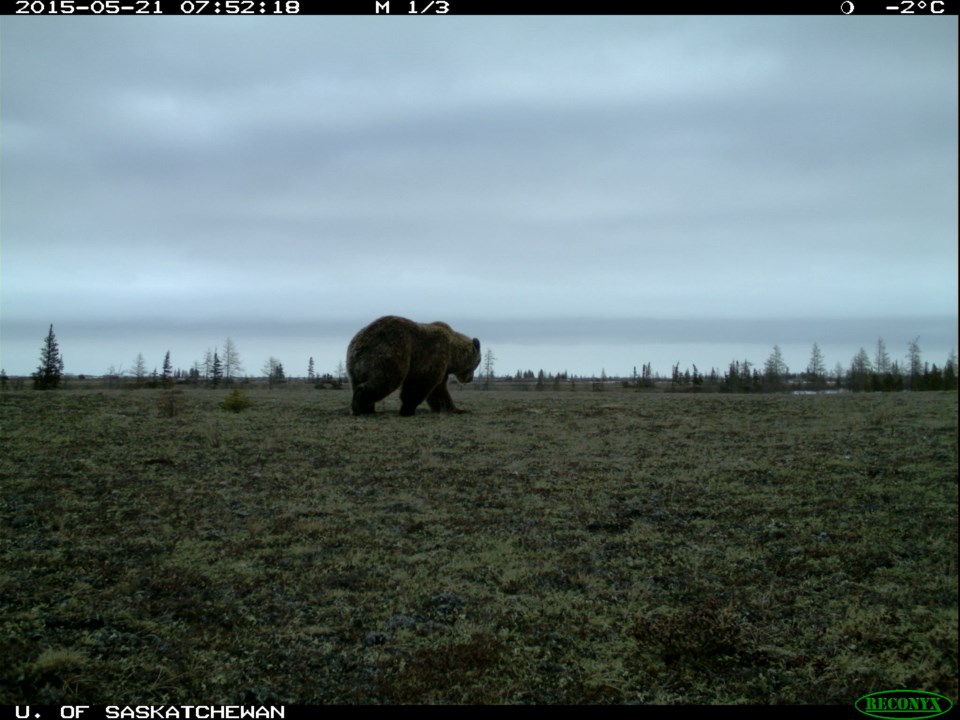Wildlife in Northern Manitoba is a usual sight, but what is not are grizzly bears in polar bear territory. A research project that started in Wapusk National Park in the province’s north has released information that grizzly bears are making their way into Northern Manitoba.
It’s not the first time a grizzly bear has been spotted in the province, says Doug Clark, an assistant professor and research chair with the University of Saskatchewan, but it’s becoming more frequent. Clark’s first sighting of a grizzly bear was in 1998, and since 2000 he says they’ve been spotted every year.
In 2009 the national park received money and built two Parks Canada field camps, which have been for tourism, research and park operations. The park got in touch with Clark to begin a project to help research polar bears in the area.
Three cameras were set up, two on Broad and Owl rivers, and one in Nester One by Cape Churchill. The cameras are motion- and heat-activated. The three questions the project wanted answered were: how frequently and when do bears visit the camps, why are they doing there, and do humans attract them or push them away?
Clark goes once a year to switch out memory cards and change the batteries, and to review the data. Although those questions aren’t all answered, the researcher noted that so far they have 200 unique polar bear visits, as well as other bear encounters, wolves, caribou, moose and even wolverines.
With the help of the cameras the researchers are able to tell what type of bear is visiting the camp, when, what season it is, and if it’s a mother with cubs, a teenaged bear or an adult male bear.
Two-thirds of the bears that have been seen have been at the Nester one Cape Churchill camp are adult bears. At the two river camps, they’ve noticed a lot of mothers and cubs.
Clark says he’s looking forward to viewing this year’s data. “This year’s data I am very interested in seeing because it’s the first year where we’ll have an environmental influence on what may be what’s going on, and I’m curious to see if that changes the bears visits.” He’s speaking about the ice breaking up early in the western part of Hudson Bay. “One of the big questions we don’t know the answer to yet is if the ice breaks up early, and they’re on shore earlier with not much to eat, are they more likely to come around camps and investigate for potential sources of food?”
While seeing polar bears is normal, it’s the grizzly bears that Clark says are very interesting to Manitobans. “It’s pretty extraordinary. There are only two places in North America where you have potential for overlap and that’s the Yukon Alaska North Slop and Northern Manitoba. This is the first time, as far as I know that someone has documented the three species [polar bear, grizzly bea and black bear] in the same place.”
For the past two years a grizzly bear has been viewed on the camera on May 21.
Clark is interested in learning if the bears are denning near the park, or in places like Nunavut and making their way down to Northern Manitoba. He says it makes sense if they’ve captured the image on the same date that they’re denning near by.
Polar bears den farther in and dig into the lake and river banks, but grizzly bears like loose river deposited soils, which are found in the park near the big rivers.
Clark said that the next time they will collect the memory card would be next spring, but that the group will be analyzing the research they have now. “I would stay tuned because we’re in the process of analyzing and writing up our results right now. We plan to get our preliminarily results to the national park and its management board this summer. We’ll be writing up a scientific paper as well and putting that through review.”
Something big has changed for grizzly bears in the region, Clark says, and he hopes to eventually find out what, but until then it will only be speculation. Clark hopes if there’s more data collected about the grizzly bears that people will continue with the cameras and collecting DNA in a non-invasive way, as well as using local and traditional knowledge about the animal, and to look at the phenomenon from a regional perspective.




